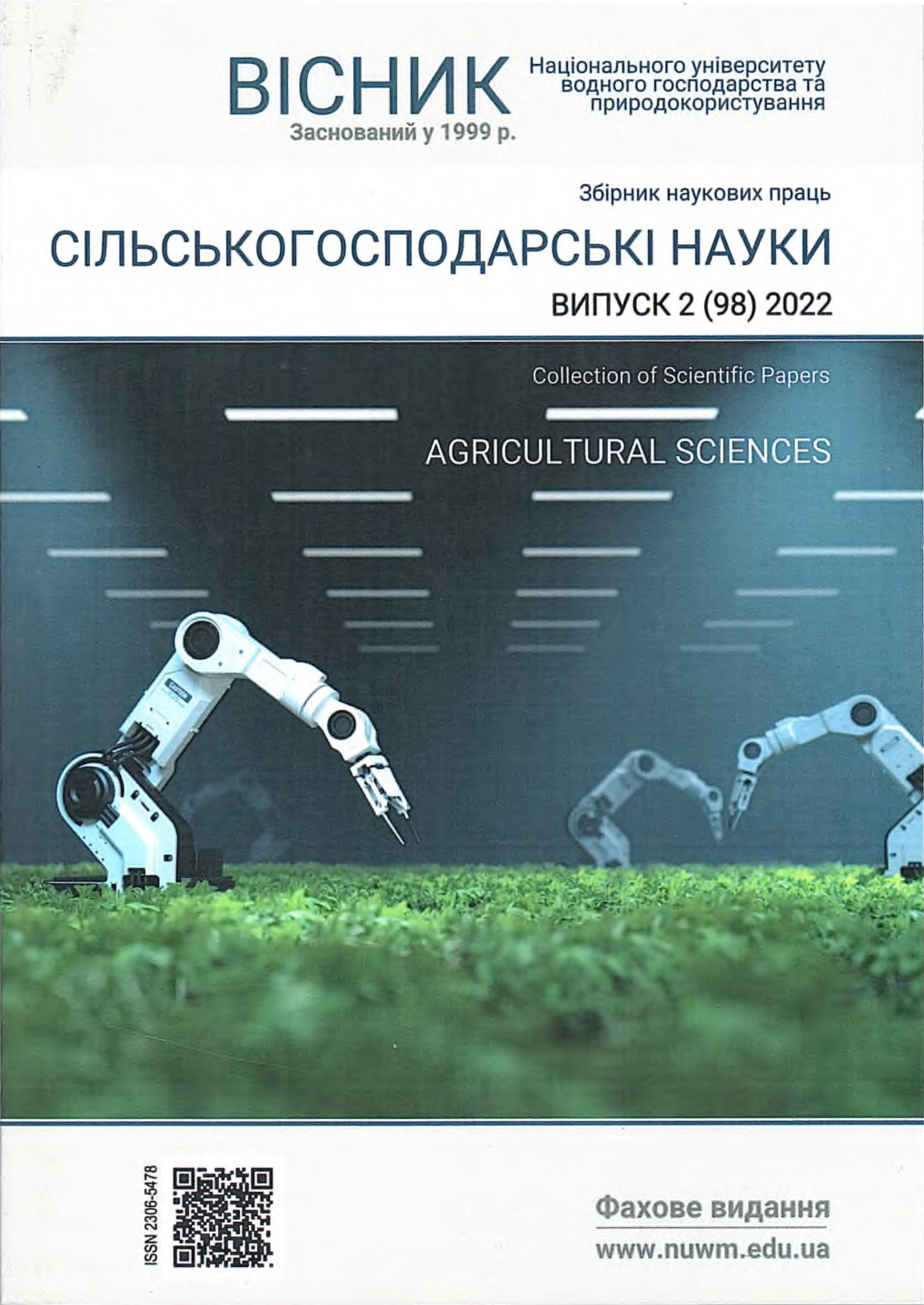SOIL AND CLIMATE BONITATION OF STEPPE SOILS OF UKRAINE USING GIS-TECHNOLOGIES
DOI:
https://doi.org/10.31713/vs220228Keywords:
soils, climate, bonitation, agricultural lands, crops, Steppe zone of Ukraine, geomodeling, GIS-technologies.Abstract
Soil and climatic conditions have an independent and complex spatial and temporal impact on the potential and degree of favorability of growing crops and yielding a crop. It is determined by the zonal physical and geographical features of the territory of the steppe regions of Ukraine–Dnipropetrovsk, Zaporizhzhia, Kirovohrad, Mykolaiv, Odesa, Kherson regions, with a general area of study of 167.4 thousand km2. The area of agricultural lands is 133.5 thousand km2, including arable lands – 113.5 thousand km2, of which the area of irrigated lands with ensured proper functioning of the infrastructure of irrigation systems is 6.3 thousand km2. In our studies we used the method of zonal soils bonitation by I.I. Karmanov. Spatial modeling was performed by using methods of geostatistics and algebra of maps of ArcGIS 10.1. software product. As a result of geomodeling, raster models were created and spatial patterns of distribution of the four components of the zonal soils bonitation were established: the total value of soil properties, humidity index, coefficient of climate continentality, average annual amount of active temperatures greater than 10° C. It was determined that in the territory of the studied steppe region, the agricultural lands of average quality prevail. Depending on the type of crops growing, their area varies from 32.0% to 72.2%, with low quality – from 1% to 13%, with high and high-end quality – from 15.5% to 67.2%. Bonitation points are established on the basis of a unified scale of assessment of land quality, which allows to objectively calculate the bioproductive potential of the territory, to determine the area of agricultural lands in terms of their qualitative characteristics, to clarify the normative monetary assessment and to determine the optimal level of agricultural land tax, to adjust irrigation rates in order to reduce the volume of water intake from natural water sources, to justify measures and terms for the reclamation of degraded lands.References
Пічура В. І. Басейнова організація природокористування на водозбірній те-риторії транскордонної річки Дніпро. Херсон : «ОЛДІ-ПЛЮС», 2020. 380 с.
Dudiak N., Pichura V., Potravka L., Stratichuk N. Environmental and economic ef-fects of water and deflation destruction of steppe soil in Ukraine. Journal of Wa-ter and Land Development. 2021. No. 50. P. 10–26. DOI10.24425/jwld.2021.138156.
Pichura V., Potravka L., Dudiak N., Stroganov A., Dyudyaeva O. Spatial differen-tiation of regulatory monetary valuation of agricultural land in conditions of wide-spread irrigation of steppe soils. Journal of water and land development. 2021. No 48 (I–III). Р. 182–196. URL: https://doi.org/10.24425/jwld.2021.136161 (дата звер-нення: 04.05.2022).
Пічура В. І. Ґрунтово-кліматичний та екологічний потенціал території транс-кордонного басейну Дніпра. Наукові доповіді НУБіП України. 2017. № 4 (68). URL: http://journals.nubip.edu.ua/index.php/Dopovidi/article/view/9101 (дата звернення: 04.05.2022).
Gerrard A. J. Soils and landforms. Nedra. 1984. 208 p.
Пічура В. І. Сільськогосподарське порушення екологічної стійкості басейну рі-чки Дніпро. Наукові доповіді НУБіП України. 2016. № 5(62). URL: http://journals.nubip.edu.ua/index.php/Dopovidi/article/view/7231/7010 (дата звернення: 04.05.2022).
Sobolev S. S., Polyansky N. A. Soil valuation. Moscow : Soil Institute named after V.V. Dokuchaeva. 1965. 812 p.
Dokuchaev V. V. Russian black earth. Report to Free Economic Society. M.-L. : Poligrafkniga. 1936. 550 p.
Sibirtsev N. M. Selected works. Moscow, 1951. 420 p.
Medvedev V. V., Plisko I. V. Bonitation and qualitative assessment of arable land in Ukraine. Kharkov : 13 printing house, 2006. 386 p.
Storie R. E. Storie index soil rating. Division of agricultural sciences. 1978. № 3203. P. 1–4.
Karmanov I. I. Soil fertility of the USSR. Moscow : Kolos, 1980. 224 p.
The system of servicing hydrometeorological information of CliWare. URL: http://cliware.meteo.ru/meteo/index.html (дата звернення: 04.05.2022).
REFERENCES:
Pichura V. I. Baseinova orhanizatsiia pryrodokorystuvannia na vodozbirnii terytorii transkordonnoi richky Dnipro. Kherson : «OLDI-PLIuS», 2020. 380 s.
Dudiak N., Pichura V., Potravka L., Stratichuk N. Environmental and economic effects of water and deflation destruction of steppe soil in Ukraine. Journal of Water and Land Development. 2021. No 50. P. 10–26. DOI10.24425/jwld.2021.138156.
Pichura V., Potravka L., Dudiak N., Stroganov A., Dyudyaeva O. Spatial differentiation of regulatory monetary valuation of agricul-tural land in conditions of widespread irrigation of steppe soils. Journal of water and land development. 2021. No 48 (I–III). Р. 182–196. URL: https://doi.org/10.24425/jwld.2021.136161 (data zvernennia: 04.05.2022).
Pichura V. I. Hruntovo-klimatychnyi ta ekolohichnyi potentsial terytorii transkordonnoho baseinu Dnipra. Naukovi dopovidi NUBiP Ukrainy. 2017. № 4(68). URL: http://journals.nubip.edu.ua/index.php/Dopovidi/article/view/9101 (data zvernennia: 04.05.2022).
Gerrard A.J. Soils and landforms. Nedra. 1984. 208p.
Pichura V.I. Silskohospodarske porushennia ekolohichnoi stiikosti baseinu richky Dnipro. Naukovi dopovidi NUBiP Ukrainy. 2016. № 5 (62). URL: http://journals.nubip.edu.ua/index.php/Dopovidi/article/view/7231/7010 (data zvernennia: 04.05.2022).
Sobolev S. S., Polyansky N. A. Soil valuation. Moscow : Soil Institute named after V.V. Dokuchaeva, 1965. 812 p.
Dokuchaev V. V. Rus-sian black earth. Report to Free Economic Society. M.-L. : Poligrafkniga, 1936. 550 p.
Sibirtsev N. M. Selected works. Moscow, 1951. 420 p.
Medvedev V. V., Plisko I. V. Bonitation and qualitative assessment of arable land in Ukraine. Kharkov : 13 printing house, 2006. 386 p.
Storie R. E. Storie in-dex soil rating. Division of agricultural sciences. 1978. № 3203. P. 1–4.
Karmanov I. I. Soil fertility of the USSR. Moscow : Kolos. 1980. 224 p.
The system of servicing hydrometeorological information of CliWare. URL: http://cliware.meteo.ru/meteo/index.html (data zvernennia: 04.05.2022).

